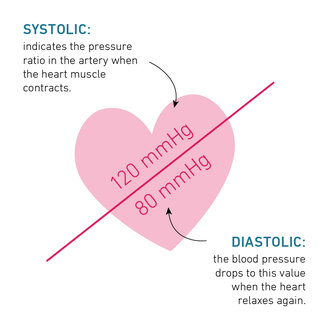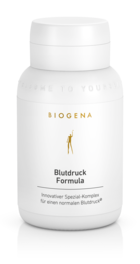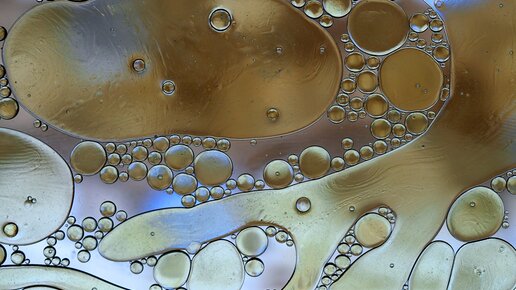What is blood pressure?
Doctors call blood pressure the pressure that the blood exerts on our vessel walls. With each heartbeat, a pressure wave builds up in the arterial system, which abates again as soon as the blood enters the organs. The highest blood pressure value is achieved during the maximum heart contraction. This value is also called the upper or systolic blood pressure. The heart muscle then relaxes again and new blood flows into the ventricles of the heart. During this relaxation phase, the blood pressure drops to the lowest level. This is called the lower or diastolic blood pressure. Certain blood pressure fluctuations during the course of the day or due to mood or activity are completely normal. However, if the blood pressure is permanently elevated, this is called hypertension, which is called high blood pressure in layman’s terms.
Keyword self monitoring – how is blood pressure measured?
If you want to monitor your blood pressure in a self-determined manner, you can supplement your doctor’s measurements from home with regular self monitoring. The blood pressure measurements show the upper (systolic) value and the lower (diastolic) value, which are stated in millimeters of the mercury column (mmHg). Optimal blood pressure in adults is below 120/80 mmHg. Values from 140/90 mmHg are classified as high blood pressure. An overview of the assessment of your measurement results can be found in Table 1.
When selecting the measuring device, semi-automatic or fully automatic blood pressure measuring devices should be used, which are usually attached to the upper arm or wrist. Before regular use, the instructions for use should be read and, if necessary, a sample measurement should be taken with the doctor or another medical-pharmaceutical specialist.

More tips on how to measure blood pressure
- Since blood pressure is influenced by many factors, individual measurements are not very meaningful. Therefore, measure your blood pressure regularly or at least over a longer period of time.
- Blood pressure fluctuates during the day. Therefore always measure at the same time of day (e.g. in the morning).
- Relax for a few minutes before taking the measurement. Sit down and breathe deeply, so that you are calm inside.
- Perform the measurement while sitting.
- Do not talk or move during the measurement.
- Always measure on the same arm and try to hold the measuring device at heart level on the wrist or upper arm while performing the procedure.
- Write your blood pressure values in a blood pressure diary.
Overview of blood pressure levels in middle-aged adults
| Systolic (mmHg) | Diastolic (mmHg) | ||
| Optimal | 120 | and | 80 |
| Normal | 120-129 | and/or | 80-84 |
| High normal | 130-139 | and/or | 85-89 |
| Grade 1 hypertension | 140-159 | and/or | 90-99 |
Grade 2 hypertension | 160-179 | and/or | 100-109 |
| Grade 3 hypertension | ≥180 | and/or | ≥110 |
| Isolierte systolische Hypertonie | 140 | and | >90 |
Table 1: Definition and classification of blood pressure values during measurement by the physician
Taking your blood pressure at home has certain advantages: It is known that the blood pressure measurement results can be changed by the presence of medical personnel. This has nothing to do with a faulty measurement. If the results between home and surgery blood pressure measurements are always different, or more precisely, the results from the doctor are always worse than those at home, this is referred to as white coat syndrome. This describes the anxiety, malaise or stress that someone feels in connection with medical “white-coated” personnel. Therefore, (correctly performed) measurements taken at home are often more meaningful.
What blood pressure is normal at what age?
The blood pressure values that are considered normal are not carved in stone, but change over a lifetime. Thus, childhood normal values are much lower than those in adulthood and depend significantly on age, height, and weight.
- Normal blood pressure values at approx. 4 years: 100 : 70
- Normal blood pressure values in children at lower secondary school: 110 : 80
- Normal blood pressure values in middle-aged adults: 120 : 60-80
- Normal blood pressure values in senior citizens: 140 : 80-85
High blood pressure (hypertension)
Systemic pressure is too high every day – this overloads the heart and other vital organs in the long term. Blood vessels calcify prematurely. Therefore, hypertension is also one of the leading causes of cardiovascular diseases. Kidneys and eyes can also suffer because of it. The crux of high blood pressure is that those affected usually feel well for a long time. Even more than this. They feel as if they could tackle anything – and so hypertension is often detected by chance, independent of age.
The good news: High blood pressure can actively be reduced by choosing a healthier lifestyle: This includes a heart-healthy, plant-based diet, avoiding toxins such as alcohol and nicotine, exercise (ideally several times a week endurance sports) and by losing any excess pounds. The latter not only benefits your well-being, but also decreases blood pressure by around 8/8 mmHg per 10 kilograms of weight loss. And last but not least, you can also get helpful support in the form of micronutrients.
Lifestyle tips: Your blood pressure friendly companions at a glance
Normalise body weight
Dealing with obesity is one of the most effective ways to lower blood pressure. Not only your well-being, but also your blood pressure clearly benefits from shedding a few pounds.
Change diet
A balanced and varied diet has a positive effect on health and the cardiovascular system.
Avoid alcohol
Men should drink under 20 g alcohol (1/2 litre beer or 1⁄4 litre wine) per day, women a maximum of 10 g. In the case of severely elevated blood pressure, please avoid alcohol completely.
Exercise and sport
The coordinated combination of endurance and strength training can reduce systolic and diastolic blood pressure. At the same time, regular exercise also increases personal well-being.
Less salt
If you are considered to be salt sensitive, the absorption of a maximum of 6 g salt per day leads to a reduction in systolic pressure by 6 mmHg, in diastolic pressure by 4 mmHg.
Peace and relaxation
Treat yourself to your daily dose of peace, you’ve earned it! At the same time, rest and relaxation also reduce blood pressure.
Hearty good nutrient partners
People who want to specifically support their blood pressure and vascular system can benefit from certain nutrients. These include the minerals potassium and magnesium as well as Omega-3 fatty acids or certain plant substances such as lycopene.
Soothing home remedies
Selected home remedies can also help relieve blood pressure. Such natural helpers include, for example, hibiscus and arnica flower tea, but garlic extract and white thorn tincture can also help “relieve pressure”.
Low blood pressure (hypotension)
Cold hands, dizziness, dullness. Although blood is actually pulsating in our veins, blood pressure that is too low (hypotension) can make itself felt from the outside. But not all hypotonic patients are suffering. Many of them have no complaints by and large.
Did you know?
“Low blood pressure is bad for life, but high blood pressure is good for death.” In fact, this old wives tale has more than a smidgen of truth here. Although it is sometimes annoying for those affected if their circulation is constantly rock bottom, hypotension per se is not a disease. In fact, just the opposite! Low arterial pressure is considered particularly gentle on our circulatory system and helps it age much more slowly than compared to high blood pressure.
But when is our blood pressure actually (too) low? Physicians generally speak of hypotension from values below 100/60 mmHg in women and 110/60 mmHg in men. The triggers can be of a different nature. This makes it possible to develop hypotension during pregnancy or due to certain medications.
However, low blood pressure can also be a sign of a disease (e.g. thyroid, heart, veins), which is why the causes of the hypotension should be clarified by a doctor so as not to overlook anything more serious. Medical advice should be sought in particular for severe symptoms such as light-headedness, seeing stars and ringing in the ears, as in the worst case scenario, the affected person might start suffering fainting fits and might thus end up in unpleasant to life-threatening situations. The good news for those involuntarily seeing stars: Our circulation can be exercised like a muscle and invigorated with simple tricks.
Would you like to learn more about nutrient products for your pulsating “cardiac circulation system”? Then perhaps the following will be exactly what your heart desires:
References
Neter, J. E. et al. 2003. Influence of weight reduction on blood pressure: a meta-analysis of randomized controlled trials. Hypertension. 42(5):878–84.
Stone, M. S. et al. 2016. Potassium Intake, Bioavailability, Hypertension, and Glucose Control. Nutrients. (8)7:444.
Capuccio, F.P., MacGregor, G.A. 1991. Does potassium supplementation lower blood pressure? A meta-analysis of published trials. J Hypertens. 9(5)465–73.
Kupetsky-Rincon, E.A., Uitto, J. 2012. Magnesium: Novel Applications in Cardiovascular Disease – A Review of the Literature. Ann Nutr Metab. 61(2):102–10.
Robinson, J.G., Stone, N.J. 2006. Antiatherosclerotic and antithrombotic effects of omega-3 acids. Am J Cardiol. 98(4A):39i–49i.
Peng, X. et al. 2014. Effect of green tea consumption on blood pressure: a meta-analysis of 13 randomized controlled trials. Sci Rep. 4:6251.
Mozos, I. et al. 2018. Lycopene and Vascular Health. Front Pharmacol. 9:521.
Gouvea, S. A. et al. 2004. Activity of angiotensin-converting enzyme after treatment with L-arginine in renovascular hypertension. Clin Exp Hypertens. 26(6):569–79.
Menzel, D. et al. 2016. L-arginine and B vitamins improve endothelial function in subjects with mild to moderate blood pressure elevation. Eur J Nutr. 57(2):557–68.
Appel, L. J. et al. 1997. A clinical trial of the effects of dietary patterns on blood pressure. DASH Collaborative Research Group. N Engl J Med. 336(16):1117-24.
Husain, K. et al. 2014. Alcohol-induced hypertension: mechanism and prevention. World J Cardiol. 6(5):245–52.
Deutsche Gesellschaft für Ernährung (DGE). www.dge.de.
Hedge, S. M., Solomon, S. D. 2015. Influence of Physical Activity on Hypertension and Cardiac Structure and Function. Curr Hypertens Rep. 17(10):77.
Grillo, A. et al. 2019. Sodium intake and hypertension. Nutrients. 11(9):1970.
Rainforth, M. V. et al. 2007. Stress reduction programs in patients with elavated [sic] blood pressure: a systematic review and meta-analysis. Curr Hypertens Rep. 9(6):520–8.
Virdis, A. et al. 2010. Cigarette smoking and hypertension. Curr Pharm Des. 16(23):2518–25.
National Institute of Health (NIH) DASH Eating Plan. https://www.nhlbi.nih.gov/health-topics/dash-eating-plan.
Svetkey, L.P. et al. 1999. The DASH Diet, Sodium Intake and Blood Pressure Trial (DASH-sodium): rationale and design. DASH-Sodium Collaborative Research Group. J Am Diet Assoc. 99(8 Suppl):S96–104.
Azadbakht, L. et al. 2011. Effects of the Dietary Approaches to Stop Hypertension (DASH) eating plan on cardiovascular risks among type 2 diabetic patients: a randomized crossover clinical trial. Diabetes Care. 34(1):55–7.
Watschinger, B. 2013. Klassifikation, Diagnostik und Therapie der arteriellen Hypertonie 2013: Empfehlungen der Österreichischen Gesellschaft für Hypertensiologie (ÖGH) (Classification, diagnostics and therapy of arterial hypertension 2013: Recommendations of the Austrian Society for Hypertension (ÖGH)). J Hyperton. 17(3):99–108
Ehret, G. B. et al. 2016. The genetics of blood pressure regulation and its target organs from association studies in 342,415 individuals. Nat Genet. 48(10): 1171–84.










